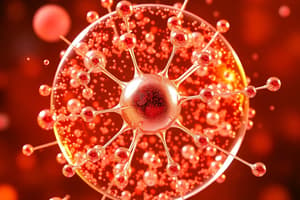Podcast
Questions and Answers
What are the characteristics of solids?
What are the characteristics of solids?
Rigidity, definite shape, fixed volume
What type of forces hold particles together in solids?
What type of forces hold particles together in solids?
Strong, directional forces (covalent and ionic bonds)
What is the arrangement of particles in a solid known as?
What is the arrangement of particles in a solid known as?
Crystal lattice
What are the characteristics of liquids?
What are the characteristics of liquids?
What type of forces hold particles together in liquids?
What type of forces hold particles together in liquids?
Explain the ability of liquids to expand or contract when subjected to external forces.
Explain the ability of liquids to expand or contract when subjected to external forces.
Describe the key characteristics of gases that differentiate them from solids and liquids.
Describe the key characteristics of gases that differentiate them from solids and liquids.
Explain the process of a solid turning into a liquid.
Explain the process of a solid turning into a liquid.
Describe the conditions under which a gas can turn into a liquid.
Describe the conditions under which a gas can turn into a liquid.
Discuss the importance of understanding the properties of solids, liquids, and gases in various applications.
Discuss the importance of understanding the properties of solids, liquids, and gases in various applications.
Study Notes
Exploring States of Matter and Particle Theory
At the core of our physical world, we find four fundamental states of matter: solids, liquids, gases, and plasmas. Each state exhibits distinct characteristics, which arise from the behavior of the particles that make up these substances. Let's delve into these states, starting with their properties and the role of particle theory in our understanding.
Solids
Solids, such as metals, rocks, and ice, are characterized by their rigidity, definite shape, and fixed volume. In solids, particles (atoms, ions, or molecules) are held together by strong, directional forces, such as covalent and ionic bonds, which are collectively known as cohesive forces. As a result, solids maintain their shape and do not expand or contract unless subjected to external forces—the reason ice cubes don't melt spontaneously in the freezer.
The arrangement of particles in a solid is called a crystal lattice, which consists of repeating patterns of atoms, ions, or molecules. These patterns create a system of fixed positions, known as a lattice structure, in which particles are located.
Liquids
Liquids, like water, oil, and mercury, are characterized by their fluidity, ability to take the shape of a container, and tendency to wet surfaces. In liquids, particles are held together by weaker, non-directional forces, such as van der Waals forces, hydrogen bonding, and electrostatic forces. Unlike solids, the particles in liquids can slide past one another, creating viscous flow.
Despite the attractive forces between particles, the distance between them is variable, allowing liquids to expand or contract when subjected to external forces. Additionally, liquids have a well-defined volume but are not constrained by a fixed shape.
Gases
Gases, such as air, hydrogen, and helium, are characterized by their expansion to fill a container, low density, and ability to diffuse through one another. In gases, particles are separated by considerable distances, and the forces between them are few and weak, such as van der Waals forces and electrostatic forces. As a result, gases are highly compressible and expand to fill their container.
Unlike solids and liquids, the volume of a gas is not fixed but can change significantly depending on the pressure and temperature applied to it. Gases are also highly permeable, allowing them to diffuse through other materials.
Changes of State
As temperatures and pressures change, matter can undergo changes from one state to another. When a solid is heated, its kinetic energy increases, and the particles begin to vibrate more vigorously. If the temperature reaches a certain threshold, called the melting point, the solid will turn into a liquid. Conversely, when a liquid is cooled, its kinetic energy decreases, and the particles become arranged in a more ordered fashion, eventually forming a solid.
Changes of state also occur under different pressures. Compressing a gas leads to a decrease in volume, and if the pressure is high enough, it can turn into a liquid via a process called liquefaction. Similarly, a liquid can be made to evaporate into a gas by decreasing its pressure.
Applications and Implications
Understanding the properties of solids, liquids, and gases is essential for various applications, such as designing materials with specific properties, understanding weather patterns, and improving energy efficiency. Moreover, the study of how particles interact and transition between states provides a deeper understanding of the fundamental principles of chemistry, thermodynamics, and statistical mechanics.
As we continue to delve into the intricacies of matter and its behavior, our ability to manipulate and utilize the states of matter will only grow. Whether it's for harnessing energy, designing more efficient materials, or exploring new frontiers of science, the study of states of matter and particle theory will remain a cornerstone of our understanding of the physical world.
Studying That Suits You
Use AI to generate personalized quizzes and flashcards to suit your learning preferences.
Description
Dive into the fundamental states of matter - solids, liquids, gases, and plasmas - and explore the role of particle theory in understanding their properties. Learn about the behavior of particles in each state, changes of state, applications in various fields, and implications for fundamental principles of chemistry and thermodynamics.



